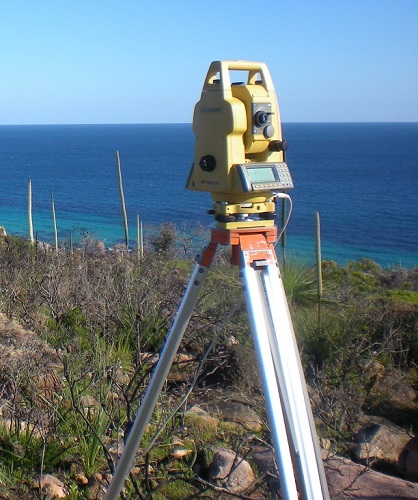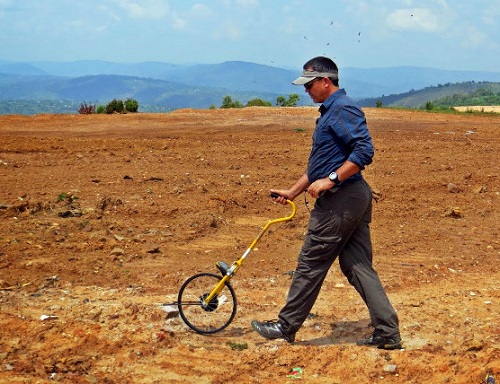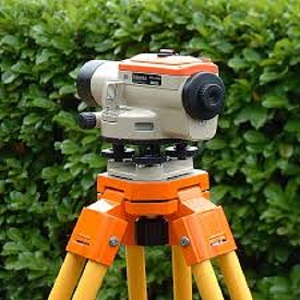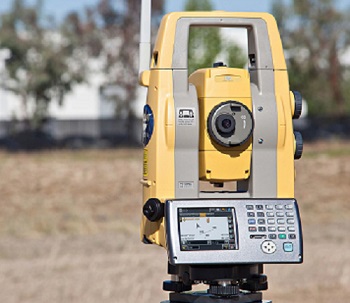Surveying instruments
Contents |
[edit] Introduction
Surveying is the process and technique of determining distances and angles between points, used on construction sites for the purposes of levelling and setting out works.
Surveying relies for its accuracy and efficiency on having the right instruments. Surveyors use a range of instruments for land surveying and mapping, and setting out.
Historically, surveying equipment might have included:
- Chains with equal size links to measure distance between two points.
- Compasses to measure the direction of a line.
- Solar compasses to measure the direction and latitude of a particular point using the sun and stars.
- Dioptra to measure angles.
- Measuring wheels to measure large distances.
Modern surveying equipment might include:
[edit] Theodolite
Theodolites were developed to measure precise horizontal and vertical angles for the purpose of triangulation – determining the location and distance of a point through the formation of triangles.
In its simplest form, a theodolite consists of a moveable telescope attached over perpendicular axis. It is mounted on a tripod head by means of a tribarch containing thumbscrews for tightening and loosening. The theodolite should be placed vertically above the point to be measured using a plumb bob or laser plummet. Tubular spirit bubbles are used to keep the instrument level.
A ‘transit’ is a type of theodolite developed in the early-19th century by railroad engineers. As well as being able to turn horizontally, a transit has a vertical circle and a telescope that can be inverted in the vertical plane.
Modern theodolites use an electronic rotary encoder to read the horizontal and vertical circles to great levels of precision.
A gyro-theodolite comprises a gyroscope mounted to a theodolite and is used, predominantly in mine surveying and tunnel engineering, to determine the orientation of true north. Gyro-theodolites were used during the construction of the Channel Tunnel to align the two tunnels as they were constructed from both France and the UK.
A tachymeter (or tacheometer) is a type of theodolite used for rapid measurements. Similar to a rangefinder, it can determine electronically or electro-optically, the distance to a target.
[edit] Measuring wheel
Surveyors use measuring wheels for quicker and lower accuracy surveys of long distances by rolling it from the start to end point. Each revolution of the wheel measures a specific distance, such as a yard or metre. Counting revolutions with a mechanical device attached to the wheel measures the distance directly.
[edit] Dumpy level
A dumpy level consists of a telescope-like device fitted on a tripod stand and used for establishing or verifying points in the same horizontal plane. Together with a vertical staff, it is used to measure height differences and transfer elevations during building surveys.
Variants include:
- Tilting level: The telescope can be flipped through 180-degrees.
- Auto level or self-levelling level: Includes an internal compensator mechanism which automatically removes any variation when set close to level. This has the advantage of ease-of-use and can be set up quickly.
- Digital electronic level: This uses electronic laser methods to read a bar-coded vertical staff.
[edit] Tripod
Most surveying instruments are fixed on a tripod, which acts as a support. Tripods have three legs which can be extended or lowered as required.
[edit] Total station
A total station (sometimes referred to as a Total Station Theodolite TST) is a modern theodolite which is a transit fitted with an electronic distance meter (EDM).
A microprocessor unit in the total station processes the data collected to determine:
- The average of multiple angles measured.
- The average of multiple distance measured.
- The horizontal distance.
- The distance between any two points.
- The elevation of objects.
- All three coordinates of the observed points.
The data that is collected and processed can be downloaded for further processing by computer aided design (CAD), building information modelling (BIM) or geographic information system (GIS) software.
These are now the most commonly used surveying instrument due to their precision and accuracy. Total stations also enable field work to be carried out rapidly with quick calculations of coordinates.
[edit] Related articles on Designing Buildings
- Building survey.
- Condition survey.
- Construction tools.
- Geophysical survey.
- Global positioning systems and global navigation satellite systems.
- How to layout a building.
- Interview with David Southam about laser scanning in construction.
- Land surveying.
- Laser scanning.
- Level.
- Levelling.
- Plumb level.
- Real time kinematic RTK.
- Robotic total station.
- Site surveys.
- Surveyor.
- Tool and equipment care and maintenance.
Featured articles and news
The benefits of engaging with insulation manufacturers
When considering ground floor constructions.
Lighting Industry endorses Blueprint for Electrification
The Lighting Industry Association fully supports the ECA Blueprint as a timely, urgent call to action.
BSRIA Sentinel Clerk of Works Training Case Study
Strengthening expertise to enhance service delivery with integrated cutting-edge industry knowledge.
Impact report from the Supply Chain Sustainability School
Free sustainability skills, training and support delivered to thousands of UK companies to help cut carbon.
The Building Safety Forum at the Installershow 2025
With speakers confirmed for 24 June as part of Building Safety Week.
The UK’s largest air pollution campaign.
Future Homes Standard, now includes solar, but what else?
Will the new standard, due to in the Autumn, go far enough in terms of performance ?
BSRIA Briefing: Cleaner Air, Better tomorrow
A look back at issues relating to inside and outside air quality, discussed during the BSRIA briefing in 2023.
Restoring Abbotsford's hothouse
Bringing the writer Walter Scott's garden to life.
Reflections on the spending review with CIAT.
Retired firefighter cycles world to raise Grenfell funds
Leaving on 14 June 2025 Stephen will raise money for youth and schools through the Grenfell Foundation.
Key points for construction at a glance with industry reactions.
Functionality, visibility and sustainability
The simpler approach to specification.
Architects, architecture, buildings, and inspiration in film
The close ties between makers and the movies, with our long list of suggested viewing.
SELECT three-point plan for action issued to MSPs
Call for Scottish regulation, green skills and recognition of electrotechnical industry as part of a manifesto for Scottish Parliamentary elections.
UCEM becomes the University of the Built Environment
Major milestone in its 106-year history, follows recent merger with London School of Architecture (LSE).
Professional practical experience for Architects in training
The long process to transform the nature of education and professional practical experience in the Architecture profession following recent reports.



























Comments